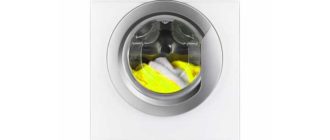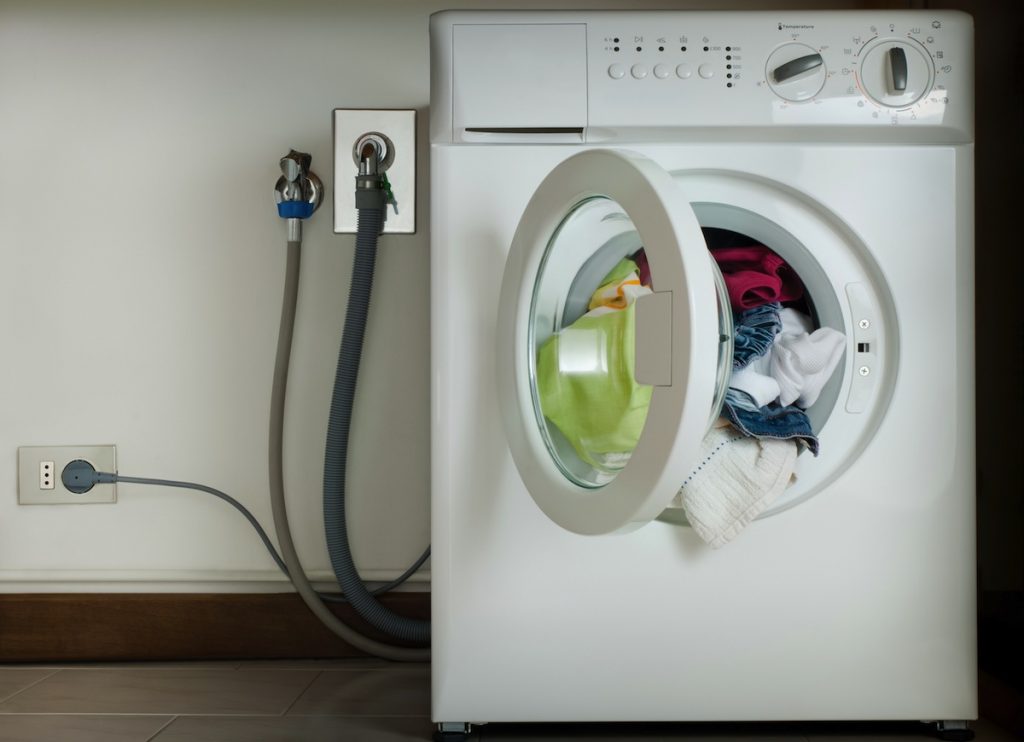 In order for the washing machine to start its work, it is necessary to draw water. Water intake takes place with the help of the filling hose, which is connected to the water supply. In order to ensure that the amount of water corresponds to the standard required for washing, the machine has a built-in pressostat. It is also called a level switch, or level sensor. Some smart machines themselves determine the amount of laundry loaded and pour just the right amount of liquid for the wash.
In order for the washing machine to start its work, it is necessary to draw water. Water intake takes place with the help of the filling hose, which is connected to the water supply. In order to ensure that the amount of water corresponds to the standard required for washing, the machine has a built-in pressostat. It is also called a level switch, or level sensor. Some smart machines themselves determine the amount of laundry loaded and pour just the right amount of liquid for the wash.
How the water moves during the wash cycle
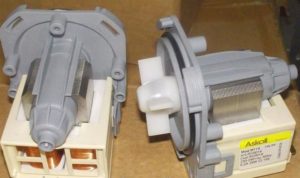 During washing, water is not only poured at the time it is needed, but also drained. This is the responsibility of the drain pump (pump). It is located in the lowest part of the washing machine. To prevent various unnecessary items from getting into the middle of the pump, a filter is installed in front of it. It serves to protect the pump from small things, such as:
During washing, water is not only poured at the time it is needed, but also drained. This is the responsibility of the drain pump (pump). It is located in the lowest part of the washing machine. To prevent various unnecessary items from getting into the middle of the pump, a filter is installed in front of it. It serves to protect the pump from small things, such as:
- Buttons;
- Paper clips;
- Coins;
- Pins;
- And so on.
These small items very often end up in the middle of the machine together with the things to be washed.
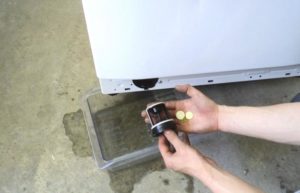 This is quite easy to do, because filter is located on the front side of the washing machine, in its lower part.
This is quite easy to do, because filter is located on the front side of the washing machine, in its lower part.
To get to it, you need to remove the bottom panel and pull out the filter. Then clean it and put it back in place. Be prepared for the fact that when you take out the filter, water will pour out. Therefore, prepare in advance a rag or a low container.
To make it easier for you to imagine the whole process of cleaning, we decided to show a video of the washing machine device.
The drain pump can take part in the washing process in other ways. For example, it can direct the circulation of water toward the dispenser or the top of the tank. Some models use another pump for this purpose.
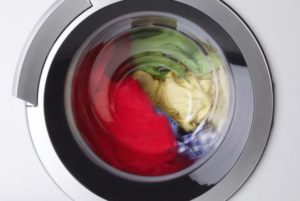 When water moves to the bottom of the washing machine tank, your detergent is completely dissolved. Due to this, the quality of washing is improved, as well as a chance to save laundry detergent.
When water moves to the bottom of the washing machine tank, your detergent is completely dissolved. Due to this, the quality of washing is improved, as well as a chance to save laundry detergent.
The solution of detergents and water is poured on things from the ribs of the tank, which are on its inner part. With their help, the laundry is mechanically affected. When the tank works, the laundry is first lifted and then falls. In many models of machines, the ribs additionally treat the laundry with a soapy solution.
When the required amount of water in the tank is filled, to work 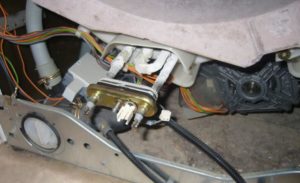 the heating element (HEATING ELEMENT). In the machine it is located under the tank. In some models it is in the back and in others in the front.
the heating element (HEATING ELEMENT). In the machine it is located under the tank. In some models it is in the back and in others in the front.
A special sensor controls the temperature of water heating, which allows you to heat water to the desired temperature, which is set in the washing program.
Drum rotation and water heating in the washing machine
 For washing to go well, we need detergent, hot or warm water and mechanical action.
For washing to go well, we need detergent, hot or warm water and mechanical action.
The detergent is a detergent or gel-type detergent, to heat the water - the heating element, and to rotate the drum - the mechanical action. The device of the washing machine motor drives drum. It is located under the tank at the bottom of the machine.
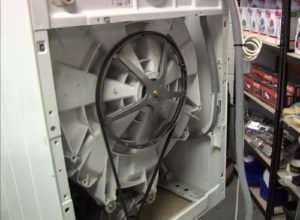 The pulley is located on the back side of the tank. The drive belt connects the motor to the pulley. The motor drives the belt and it transmits the rotation to the drum inside the tank. This design is considered conventional, but it has its own disadvantages, because the belt is constantly in contact with moving elements, creating a friction effect. Therefore, over time, it wears out. Another disadvantage of this design is the vibration of the machine.
The pulley is located on the back side of the tank. The drive belt connects the motor to the pulley. The motor drives the belt and it transmits the rotation to the drum inside the tank. This design is considered conventional, but it has its own disadvantages, because the belt is constantly in contact with moving elements, creating a friction effect. Therefore, over time, it wears out. Another disadvantage of this design is the vibration of the machine.
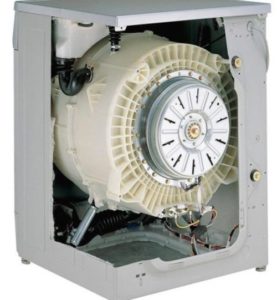 In more advanced models of washing machines, the belt drive is not used. It is replaced by the direct drive. It is actively used in LG (LG) washing machines. In these models, the motor is attached directly to the drum. This design uses less energy to rotate the drum, reduces vibration and saves space inside the machine.
In more advanced models of washing machines, the belt drive is not used. It is replaced by the direct drive. It is actively used in LG (LG) washing machines. In these models, the motor is attached directly to the drum. This design uses less energy to rotate the drum, reduces vibration and saves space inside the machine.
There is less noise from this motor and the direct drive allows the machines to be more compact.
Washing and spinning
During laundry, the drum rotates first in one direction and then the other side at relatively low speed. During the spin, however, the spin speed reaches its maximum.
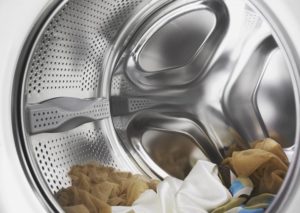 Thanks to the centrifugal force, the liquid from the spinning laundry escapes through small holes in the tank. And the drain pump takes it out.
Thanks to the centrifugal force, the liquid from the spinning laundry escapes through small holes in the tank. And the drain pump takes it out.
When spinning, the spin speed increases gradually. This is to ensure that the things are placed evenly on the surface of the drum. Also due to this you can avoid strong vibrations.
If the inside of the tank is out of balance, then the spinning speed of the machine decreases again, and then it is distributed inside the machine again. It then picks up speed again and wringing continues. As you can see, the device of the washing machine automatic is quite intricate.
Control module
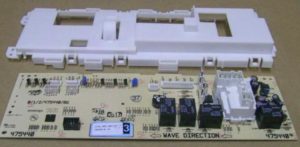 All the processes that occur during the washing are controlled by the control module.
All the processes that occur during the washing are controlled by the control module.
It controls the time of connecting or disconnecting the heating element, turns on the drain pump when it is necessary to drain the water from the tank. It also decides when the drum should rotate and at what speed.
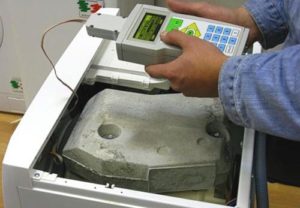 It also monitors the readings of the various sensors, which are provided during the washing. No modern washing machine can do without this control system.
It also monitors the readings of the various sensors, which are provided during the washing. No modern washing machine can do without this control system.
The control module is the most expensive part of the machine. It is very expensive, as it has a complex device. Therefore, if this part of the machine is damaged, it is not recommended to replace it yourself.
Drum and tank.
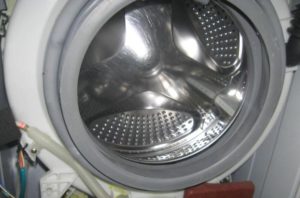 Inside the tank of the washing machine is the drum. This is where we put the dirty things. The tank is automatically filled with water and detergent. Since there are many small holes in the tank, the detergent and water mix with the things and wash them.
Inside the tank of the washing machine is the drum. This is where we put the dirty things. The tank is automatically filled with water and detergent. Since there are many small holes in the tank, the detergent and water mix with the things and wash them.
Manufacturers make the drum from stainless steel, and the tank can be either stainless steel or plastic. Most often it consists of two parts, but sometimes you come across tanks consisting of a whole "piece". There are people who, in an acute need, can saw a non-separable tank into two parts, and then use bolts and sealant that does not let water in, connect them together.
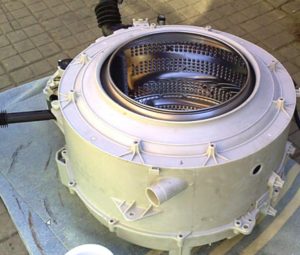 In some models of machines, the tanks are installed at an angle. But most often they are mounted horizontally.
In some models of machines, the tanks are installed at an angle. But most often they are mounted horizontally.
If you are one of those people who prefer to see once rather than hear a hundred times, we offer a video.
In this video you can see not only what a washing machine consists of, but also its brief history. Enjoy watching and good luck learning about the construction of washing machines.



